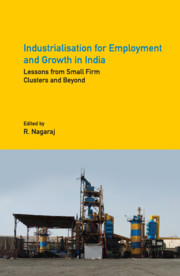Book contents
- Frontmatter
- Contents
- List of Tables
- List of Figures and Maps
- Preface and Acknowledgements
- 1 Introduction
- 2 Garment Cluster in Kolkata: The Untold Story of Expansion Relying on Low-end Domestic Demand
- 3 Constraints to Upgrading and Employment Expansion in the Tiruppur Knitwear Cluster
- 4 Determinants of Employment in the Indian Automobile Industry
- 5 Upgrading Technology and Space as Collective Strategy: Creation of Jobs and Market Potential in Gujarat’s Ceramic Clusters
- 6 Sports Equipment Manufacturing in India: A Firm-level Inquiry into Growth and Employment Dynamism
- 7 Aligarh Lock Cluster: Unravelling the Major Impediments
- 8 Continued Misery or a Change in Fortune? The Case of the Howrah Foundry Industry
- 9 Redevelop and Perish, or Survive and Grow? The Case for Supporting Informal Leather Enterprises in Dharavi, Mumbai
- 10 Growth Performance, Competitiveness and Employment in MSMEs: A Case Study of the Rajkot Engineering Cluster
- 11 Manufacturing and Automation
- About the Contributors
- Index
1 - Introduction
Published online by Cambridge University Press: 31 July 2021
- Frontmatter
- Contents
- List of Tables
- List of Figures and Maps
- Preface and Acknowledgements
- 1 Introduction
- 2 Garment Cluster in Kolkata: The Untold Story of Expansion Relying on Low-end Domestic Demand
- 3 Constraints to Upgrading and Employment Expansion in the Tiruppur Knitwear Cluster
- 4 Determinants of Employment in the Indian Automobile Industry
- 5 Upgrading Technology and Space as Collective Strategy: Creation of Jobs and Market Potential in Gujarat’s Ceramic Clusters
- 6 Sports Equipment Manufacturing in India: A Firm-level Inquiry into Growth and Employment Dynamism
- 7 Aligarh Lock Cluster: Unravelling the Major Impediments
- 8 Continued Misery or a Change in Fortune? The Case of the Howrah Foundry Industry
- 9 Redevelop and Perish, or Survive and Grow? The Case for Supporting Informal Leather Enterprises in Dharavi, Mumbai
- 10 Growth Performance, Competitiveness and Employment in MSMEs: A Case Study of the Rajkot Engineering Cluster
- 11 Manufacturing and Automation
- About the Contributors
- Index
Summary
The Context
In 2017–18, the manufacturing sector (industry) accounted for 18 per cent (31.2 per cent) of India's gross domestic output (GDP) at constant prices. The corresponding ratio for employment is 12.1 per cent (27 per cent), as per the periodic labour force survey (PLFS) data. As the ratios have barely inched up for over 25 years (Figure 1.1), it is a sign of industrial stagnation (Nagaraj 2017). Moreover, after initiating the liberal (free-market) economic reforms in 1991, import and technological dependence have risen (Chaudhuri 2013; Mani 2018).
However, a boom in information technology (IT) services and their exports has more than compensated for industrial stagnation, as India's output growth accelerated. After joining the World Trade Organisation (WTO) in 2001, if China came to be known as the world's factory, many believed that India was on its way to becoming the world's back office. For a while, India seemed to be on course, catching up with China, but it faltered suddenly.
The global financial crisis in 2008, the great recession after that and the rising threats of a trade war have taken the sheen out of India's performance and put paid to its global ambition. Meanwhile, China has graduated from assembling low-quality consumer goods to a technologically dominant nation – for example, Huawei's pole position in the telecom technology market – with world-beating firms and brands, both in high-tech manufacturing and IT services.
Realising the limits to the growth of the new services without the backing of a sound manufacturing base, the National Manufacturing Policy, 2011, sought to raise the sector's share in GDP to 25 per cent and to create 100 million additional manufacturing sector jobs by 2025. Though the policy failed to take off, the document helped articulate the need for industrialisation – or re-industrialisation – as an imperative for long-term national development.
In 2015, the policy was recast as the ‘Make in India’ initiative, with the following objectives:
1. The target of an increase in manufacturing sector
growth rate to 12–14 per cent per annum over the medium term.
2. An increase in the share of manufacturing in the country's GDP from 16 per cent to 25 per cent by 2022.
- Type
- Chapter
- Information
- Industrialisation for Employment and Growth in IndiaLessons from Small Firm Clusters and Beyond, pp. 1 - 23Publisher: Cambridge University PressPrint publication year: 2021



